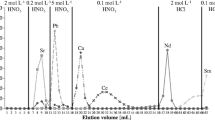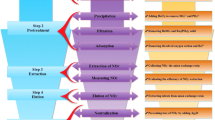Abstract
The development of mercury (Hg) stable isotope measurements has enhanced the study of Hg sources and transformations in the environment. As a result of the mixing of inorganic Hg (iHg) and methylmercury (MeHg) species within organisms of the aquatic food web, understanding species-specific Hg stable isotopic compositions is of significant importance. The lack of MeHg isotope measurements is due to the analytical difficulty in the separation of the MeHg from the total Hg pool, with only a few methods having been tested over the past decade with varying degrees of success, and only a handful of environmentally relevant measurements. Here, we present a novel anion-exchange resin separation method using AG 1-X4 that further isolates MeHg from the sample matrix, following a distillation pretreatment, in order to obtain ambient MeHg stable isotopic compositions. This method avoids the use of organic reagents, does not require complex instrumentation, and is applicable across matrices. Separation tests across sediment, water, and biotic matrices showed acceptable recoveries (98 ± 5%, n = 54) and reproducible δ202Hg isotope results (2 SDs ≤ 0.15‰) down to 5 ng of MeHg. The measured MeHg pools in natural matrices, such as plankton and sediments, showed large deviations from the non-speciated total Hg measurement, indicating that there is an important isotopic shift during methylation that is not recorded by typical measurements, but is vital in order to assess sources of Hg during bioaccumulation.

Graphical abstract



Similar content being viewed by others
References
Ullrich SM, Tanton TW, Abdrashitova SA. Mercury in the aquatic environment: a review of factors affecting methylation. Crit Rev Environ Sci Technol. 2001;31:241–93.
Compeau GC, Bartha R. Sulfate-reducing bacteria: principal methylators of mercury in anoxic estuarine sediment. Appl Environ Microbiol. 1985;50:498.
Gilmour CC, Podar M, Bullock AL, Graham AM, Brown SD, Somenahally AC, et al. Mercury methylation by novel microorganisms from new environments. Environ Sci Technol. 2013;47:11810–20.
Hsu-Kim H, Kucharzyk KH, Zhang T, Deshusses MA. Mechanisms regulating mercury bioavailability for methylating microorganisms in the aquatic environment: a critical review. Environ Sci Technol. 2013;47:2441–56.
Munson KM, Lamborg CH, Boiteau RM, Saito MA. Dynamic mercury methylation and demethylation in oligotrophic marine water. Biogeosciences. 2018;15:6451–60.
Lehnherr I, St. Louis VL, Hintelmann H, Kirk JL. Methylation of inorganic mercury in polar marine waters. Nat Geosci. 2011;4:298–302.
Eckley CS, Hintelmann H. Determination of mercury methylation potentials in the water column of lakes across Canada. Sci Total Environ. 2006;368:111–25.
Bloom NS. On the chemical form of mercury in edible fish and marine invertebrate tissue. Can J Fish Aquat Sci. 1992;49:1010–7.
Lescord GL, Johnston TA, Branfireun BA, Gunn JM. Percentage of methylmercury in the muscle tissue of freshwater fish varies with body size and age and among species. Environ Toxicol Chem. 2018;37:2682–91.
UN Environment Economy Division, Report by UN Environment, The World Health Organization and Italian National Research Council - Institute of Atmospheric Pollution Research Regarding the Activities of the Global Environment Facility Project: development of a plan for global monitoring of human exposure to and environmental concentrations of mercury
Blum JD, Sherman LS, Johnson MW. Mercury isotopes in earth and environmental sciences. Annu Rev Earth Planet Sci. 2014;42:249–69.
Bergquist BA, Blum JD. Mass-dependent and -independent fractionation of Hg isotopes by photoreduction in aquatic systems. Science. 2007;318:417–20.
Schauble EA. Applying stable isotope fractionation theory to new systems. Rev Mineral Geochem. 2004;55:65–111.
Wiederhold JG. Metal stable isotope signatures as tracers in environmental geochemistry. Environ Sci Technol. 2015;49:2606–24.
Young ED, Galy A, Nagahara H. Kinetic and equilibrium mass-dependent isotope fractionation laws in nature and their geochemical and cosmochemical significance. Geochim Cosmochim Acta. 2002;66:1095–104.
Schauble EA. Role of nuclear volume in driving equilibrium stable isotope fractionation of mercury, thallium, and other very heavy elements. Geochim Cosmochim Acta. 2007;71:2170.
Buchachenko AL, Kouznetsov DA, Shishkov AV. Spin biochemistry: magnetic isotope effect in the reaction of creatine kinase with CH3HgCl. J Phys Chem A. 2004;108:707–10.
Rodriguez-Gonzalez P, Epov VN, Bridou R, Tessier E, Guyoneaud R, Monperrus M, et al. Species-specific stable isotope fractionation of mercury during Hg(II) methylation by an anaerobic bacteria (Desulfobulbus propionicus) under dark conditions. Environ Sci Technol. 2009;43:9183.
Kritee K, Barkay T, Blum JD. Mass dependent stable isotope fractionation of mercury during mer mediated microbial degradation of monomethylmercury. Geochim Cosmochim Acta. 2009;73(5):1285.
Tsui MTK, Blum JD, Kwon SY, Finlay JC, Balogh SJ, Nollet YH. Sources and transfers of methylmercury in adjacent river and forest food webs. Environ Sci Technol. 2012;46:10957–64.
Masbou J, Point D, Sonke JE. Application of a selective extraction method for methylmercury compound specific stable isotope analysis (MeHg-CSIA) in biological materials. J Anal Atom Spectrom. 2013;28:1620–8.
Janssen SE, Johnson MW, Blum JD, Barkay T, Reinfelder JR. Separation of monomethylmercury from estuarine sediments for mercury isotope analysis. Chem Geol. 2015;411:19–25.
Yang L, Sturgeon RE. Isotopic fractionation of mercury induced by reduction and ethylation. Anal Bioanal Chem. 2009;393:377–85.
Epov VN, Rodriguez-Gonzalez P, Sonke JE, Tessier E, Amouroux D, Bourgoin LM, et al. Simultaneous determination of species-specific isotopic composition of Hg by gas chromatography coupled to multicollector ICPMS. Anal Chem. 2008;80:3530–8.
Epov VN, Berail S, Jimenez-Moreno M, Perrot V, Pecheyran C, Amouroux D, et al. Approach to measure isotopic ratios in species using multicollector-ICPMS coupled with chromatography. Anal Chem. 2010;82:5652–62.
Dzurko M, Foucher D, Hintelmann H. Determination of compound-specific Hg isotope ratios from transient signals using gas chromatography coupled to multicollector inductively coupled plasma mass spectrometry (MC-ICP/MS). Anal Bioanal Chem. 2008;393:345.
Bouchet S, Bérail S, Amouroux D. Hg Compound specific isotope analysis at ultratrace levels using an on line gas chromatographic preconcentration and separation strategy coupled to multicollector-inductively coupled plasma mass spectrometry. Anal Chem. 2018;90:7809–16.
Rodríguez-González P, Epov VN, Pecheyran C, Amouroux D, Donard OFX. Species-specific stable isotope analysis by the hyphenation of chromatographic techniques with MC-ICPMS. Mass Spectrom Rev. 2011;31:504–21.
Entwisle J, Malinovsky D, Dunn PJH, Goenaga-Infante H. Hg isotope ratio measurements of methylmercury in fish tissues using HPLC with off line cold vapour generation MC-ICPMS. J Anal Atom Spectrom. 2018;33:1645–54.
Chen J, Hintelmann H, Dimock B. Chromatographic pre-concentration of Hg from dilute aqueous solutions for isotopic measurement by MC-ICP-MS. J Anal Atom Spectrom. 2010;25:1402–9.
Štrok M, Hintelmann H, Dimock B. Development of pre-concentration procedure for the determination of Hg isotope ratios in seawater samples. Anal Chim Acta. 2014;851:57–63.
Alderighi L, Gans P, Midollini S, Vacca A. Co-ordination chemistry of the methylmercury(II) ion in aqueous solution: a thermodynamic investigation. Inorg Chim Acta. 2003;356:8–18.
Korkisch J. Handbook of ion exchange resins: their application in inorganic analytical chemistry. Boca Raton: CRC; 1989.
Malinovsky D, Latruwe K, Moens L, Vanhaecke F. Experimental study of mass-independence of Hg isotope fractionation during photodecomposition of dissolved methylmercury. J Anal Atom Spectrom. 2010;25:950.
U.S. EPA. Method 1630 methyl mercury in water by distillation, aqueous ethylation, purge and trap, and cold vapor atomic fluorescence spectrometry. 1998.
U.S. EPA. Method 1631 revision E: mercury in water by oxidation, purge and trap, and cold vapor atomic fluorescence spectrometry. EPA-821-R-02-019. 2002.
Delgado A, Prieto A, Zuloaga O, Diego A, Madariaga JM. Production of artifact methylmercury during the analysis of certified reference sediments: use of ionic exchange in the sample treatment step to minimise the problem. Anal Chim Acta. 2007;582:109–15.
Sanz J, Raposo JC, Larreta J, Martinez-Arkarazo I, Diego A, Madariaga JM. On-line separation for the speciation of mercury in natural waters by flow injection-cold vapour-atomic absorption spectrometry. J Sep Sci. 2004;27:1202–10.
Shetty P, Moosavi-Movahedi AA, Rengan K. Determination of trace level mercury in biological and environmental samples by neutron activation analysis. J Radioanal Nucl Chem. 1994;182:205–11.
Parker JL, Bloom NS. Preservation and storage techniques for low-level aqueous mercury speciation. Sci Total Environ. 2005;337:253–63.
Janssen SE, Lepak RF, Tate MT, Ogorek JM, DeWild JF, Babiarz CL, et al. Rapid pre-concentration of mercury in solids and water for isotopic analysis. Anal Chim Acta. 2018;1054:95–103.
Yin R, Krabbenhoft DP, Bergquist BA, Zheng W, Lepak RF, Hurley JP. Effects of mercury and thallium concentrations on high precision determination of mercury isotopic composition by Neptune Plus multiple collector inductively coupled plasma mass spectrometry. J Anal Atom Spectrom. 2016;31:2060–8.
Blum JD, Bergquist B. Reporting of variations in the natural isotopic composition of mercury. Anal Bioanal Chem. 2007;388:353.
National Institute of Standards and Technology. Report of investigation: RM8610—mercury isotopes in UM Almadén mono-elemental secondary standard. 2017. https://www-s.nist.gov/srmors/certificates/8610.pdf.
Rosera TJ, Janssen SE, Tate MT, Lepak RF, Ogorek JM, DeWild JF, et al. Isolation of methylmercury using distillation and anion-exchange chromatography for isotopic analyses in natural matrices data release: U.S. Geol Surv. 2019. https://doi.org/10.5066/P9LRHNL5.
Qin C, Chen M, Yan H, Shang L, Yao H, Li P, et al. Compound specific stable isotope determination of methylmercury in contaminated soil. Sci Total Environ. 2018;644:406–12.
Janssen SE, Schaefer JK, Barkay T, Reinfelder JR. Fractionation of mercury stable isotopes during microbial methylmercury production by iron- and sulfate-reducing bacteria. Environ Sci Technol. 2016;50:8077–83.
Kwon SY, Blum JD, Chen CY, Meattey DE, Mason RP. Mercury isotope study of sources and exposure pathways of methylmercury in estuarine food webs in the Northeastern U.S. Environ Sci Technol. 2014;48:10089–97.
Gehrke GE, Blum JD, Slotton DG, Greenfield BK. Mercury isotopes link mercury in San Francisco bay forage fish to surface sediments. Environ Sci Technol. 2011;45:1264.
Chasar LC, Scudder BC, Stewart AR, Bell AH, Aiken GR. Mercury cycling in stream ecosystems. 3. Trophic dynamics and methylmercury bioaccumulation. Environ Sci Technol. 2009;43:2733–9.
Madenjian CP, Janssen SE, Lepak RF, Ogorek JM, Rosera TJ, DeWild JF, et al. Mercury isotopes reveal an ontogenetic shift in habitat use by walleye in lower Green Bay of Lake Michigan. Environ Sci Technol Lett. 2019;6:8–13.
Kritee K, Motta LC, Blum JD, Tsui MT, Reinfelder JR. Photochemical visible light-induced magnetic mass independent fractionation of mercury in a marine microalga. Earth Space Chem. 2017;2(5):432–40.
Funding
This work was supported by the USGS Toxic Substances Hydrology Program. Support for TJR was provided by the Wisconsin Alumni Research Foundation through the University of Wisconsin Graduate School (award no. MSN194130) and through a U.S. Geological Survey - National Institutes for Water Resources internship under Cooperative Agreement G18ACOO3S4. Any use of trade, firm, or product names in this publication is for descriptive purposes only and does not imply the endorsement by the U.S. Government.
Author information
Authors and Affiliations
Corresponding author
Ethics declarations
Conflict of interest
The authors declare that they have no conflict of interest.
Additional information
Publisher’s note
Springer Nature remains neutral with regard to jurisdictional claims in published maps and institutional affiliations.
Electronic supplementary material
ESM 1
(PDF 857 kb)
Rights and permissions
About this article
Cite this article
Rosera, T.J., Janssen, S.E., Tate, M.T. et al. Isolation of methylmercury using distillation and anion-exchange chromatography for isotopic analyses in natural matrices. Anal Bioanal Chem 412, 681–690 (2020). https://doi.org/10.1007/s00216-019-02277-0
Received:
Revised:
Accepted:
Published:
Issue Date:
DOI: https://doi.org/10.1007/s00216-019-02277-0




